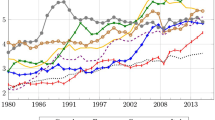Abstract
The consumption function for the U.S. economy is estimated with real estate and financial wealth for quarterly data for 1952:1–2001:4. An additional dollar of real estate wealth increases consumption by 8 cents in the current year, as compared with only 2 cents for financial wealth. The results are consistent with theoretical bounds on the marginal propensity to consume from aggregate wealth. The decline in the stock market during 2000–2001 had a limited impact on aggregate demand in part because of an offsetting real estate wealth effect.
Similar content being viewed by others
References
Ando, A., and F. Modigliani. (1963). \ldThe \lsLife Cycle\rs Hypothesis of Saving: Aggregate Implications and Tests,\rd American Economic Review 53, 55–84.
Bertaut, C. (1998). \ldStockholding Behavior of U.S. Households: Evidence from the 1983–1989 Survey of Consumer Finances,\rd Review of Economics and Statistics 80, 263–275.
Brayton, F., and P. Tinsley. (1996). \ldA Guide to FRB/US,\rd Federal Reserve Board Discussion Paper 42.
Case, Karl E., J. M. Quigley, and R. J. Shiller. (2001). \ldComparing Wealth Effects: The Stock Market Versus the Housing Market,\rd Cambridge, MA: National Bureau of Economic Research, Working Paper 8606.
Davis, M. A., and M. G. Palumbo. (2001). \ldA Primer on the Economics and Time Series Econometrics of Wealth Effects,\rd Washington, DC: Federal Reserve Board, Finance and Economics Discussion Series, Discussion Paper 2001-09.
Dickinson, A., and A. Heuson. (1994). \ldMortgage Prepayment: Past and Present,\rd Journal of Real Estate Literature 2, 11–33.
Elliott, J. W. (1980). \ldWealth and Wealth Proxies in a Permanent Income Model,\rd Quarterly Journal of Economics 95, 509–535.
Engle, R. F., and C. W. J. Granger. (1987). \ldCo-Integration and Error Correction: Representation, Estimation, and Testing,\rd Econometrica 55, 251–276.
Engelhardt, G. V. (1996). \ldHouse Prices and Home Owner Saving Behavior,\rd Regional Science and Urban Economics 26, 313–336.
Giliberto, M., and T. G. Thibodeau. (1989). \ldModeling Conventional Residential Mortgage Refinancings,\rd Journal of Real Estate Finance and Economics 2, 285–299.
Goetzmann, W. N., and M. Spiegel. (2000). \ldThe Policy Implications of Portfolio Choice in Underserved Markets,\rd Working Paper 00-18, Yale Center for Finance.
Greenspan, A. (2001). Speech to the 2001 Kansas City Federal Reserve Monetary Policy Conference, Jackson Hole, Wyoming.
Hoynes, H. W., and D. L. McFadden. (1997). \ldThe Impact of Demographics on Housing and Nonhousing Wealth in the United States.\rd In M. D. Hurd, and Y. Naohiro (eds.), The Economic Effects of Aging in the United States and Japan. Chicago: University of Chicago Press for NBER, pp. 153–194.
Hurst, E., and F. Stafford. (2002). \ldHome Is Where the Equity Is: Liquidity Constraints, Refinancing and Consumption,\rd Mimeo, University of Chicago.
Johansen, S. (1995). Likelihood-Based Inference in Cointegrated Vector Autoregressive Models. Oxford: Oxford University Press.
Juster, F. T., J. Lupton, J. P. Smith, and F. Stafford. (1999). \ldSavings and Wealth: Then and Now,\rd University of Michigan Discussion Paper.
Kau, J. B., and D. C. Keenan. (1995). \ldAn Overview of the Option-Theoretic Pricing of Mortgages,\rd Journal of Housing Research 6, 217–244.
Kennickell, A. B., M. Starr-McCluer, and B. Surette. (2000). \ldRecent Changes in U.S. Family Finances: Results from the 1998 Survey of Consumer Finances,\rd Federal Reserve Bulletin 86, 1–29.
Muellbauer, J. (1994). \ldThe Assessment: Consumer Expenditure,\rd Oxford Review of Economic Policy 10, 1–41.
Poterba, J., and A. Samwick. (1995). \ldStock Ownership Patterns, Stock Market Fluctuations and Consumption,\rd Brookings Papers on Economic Activity 2, 295–357.
Poterba, J. (2000). \ldStock Market Wealth and Consumption,\rd Journal of Economic Perspectives 14, 99–118.
Shleifer, A. (1995). Comment on \ldStock Ownership Patterns, Stock Market Fluctuations and Consumption,\rd Brookings Papers on Economic Activity 2, 358–359.
Souleles, N. S. (1999). \ldThe Response of Household Consumption to Income Tax Refunds,\rd American Economic Review 89, 947–973.
Stanton, R. (1995). \ldRational Prepayment and the Valuation of Mortgage Backed Securities,\rd Review of Financial Studies 8(3), 676–708.
Zhang, H. H. (1997). \ldEndogenous Borrowing Constraints with Incomplete Markets,\rd Journal of Finance 52, 2187–2209.
Author information
Authors and Affiliations
Rights and permissions
About this article
Cite this article
Benjamin, J.D., Chinloy, P. & Jud, G.D. Real Estate Versus Financial Wealth in Consumption. The Journal of Real Estate Finance and Economics 29, 341–354 (2004). https://doi.org/10.1023/B:REAL.0000036677.42950.98
Issue Date:
DOI: https://doi.org/10.1023/B:REAL.0000036677.42950.98




